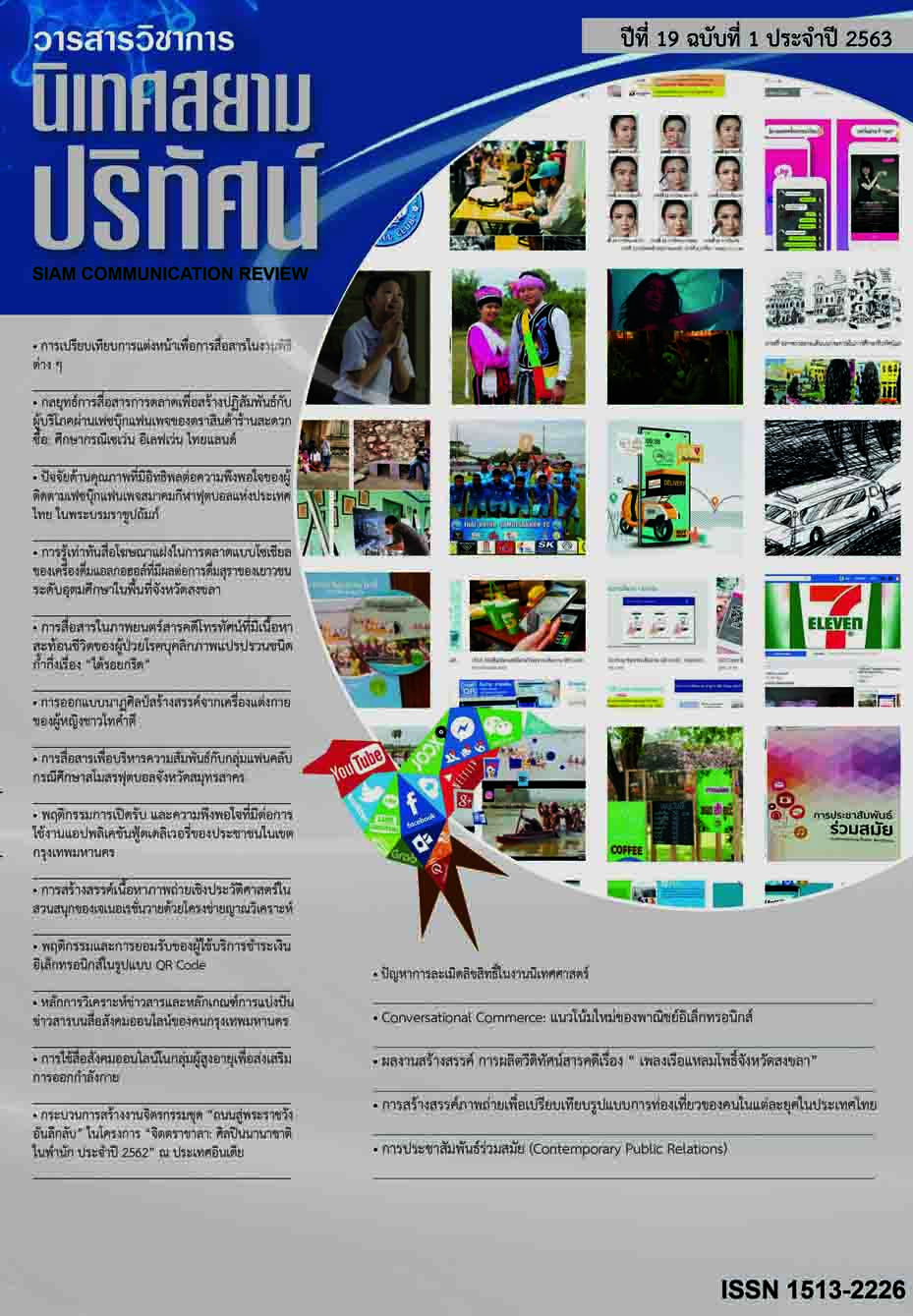Using social media in the elderly group for promoting physical exercise
Main Article Content
Abstract
In the year 2021, Thailand will enter "Complete aged society” the population of ages 60 years and older account for 20 percent of the total population. Important problems that elderlies face are about health issues caused by many changes in the body that affect the system of various organs that are clearly observed, such as a decrease in tolerance, agility, and strength. Elderlies who do not rehabilitate to improve their health will experience chronic illness that causes physical fitness to be lower than it should be, so it is important to encourage exercise. For the elderly to live longer with quality exercise, activities will vary according to the health and ability of each elderly person. There are many ways to improve elderly’s health, such as walking or running slowly, exercise, swimming and water exercises, riding a bicycle and dancing.
Social media today is an important channel used to transmit information about exercise in many aspects, especially health knowledge, in order to distribute the correct information. The most popular social media used by the elderly is Line, followed by YouTube and Facebook. The use of social media is both positive and negative. The positive way is to develop relationships and find new friends and engage in participation and exchange of opinions on various matters. At the same time, it can also create a negative impact, including the spread of unreliable and false information. Elderlies prefer to share health information that may be convincing but not necessarily reliable, which can have negative impact. Therefore, when using social media, the elder needs to have knowledge and analytical skills. The information received must have a goal to use and be used properly. There should be an agency responsible for developing programs to increase knowledge and recommend the use of social media, for all seniors to be able to use media to recognize useful information. There should be a main unit to recommend content producers to make clips on exercise and health care that are diverse, appropriate, and reliable.
Article Details
References
กฤษณาพร ทิพย์กาญจนเรขา และคณะ. (2560). พฤติกรรมการแสวงหาข้อมูลสุขภาพจากสื่อออนไลน์และสื่อสังคมของผู้สูงอายุ ตามระดับการรับรู้ภาวะสุขภาพ. วารสารวิจัยทางวิทยาศาสตร์สุขภาพ, 11(ฉบับพิเศษ), 33 -42.
เชียง เภาชิต และ พรรณราย เทียมทัน. (2559). การพัฒนารูปแบบกิจกรรมส่งเสริมสุขภาพ ผู้สูงอายุในจังหวังนครสวรรค์. วารสารสุทธิปริทัศน์, 30(94), หน้า 112 – 127.
พิชญาวี คณะผล. (2561). พฤติกรรมการใช้และผลการใช้บริการเครือข่ายสังคมออนไลน์ของผู้สูงอายุในจังหวัดนนทบุรี (รายงานการวิจัย). ปทุมธานี: มหาวิทยาลัยราชพฤกษ์.
มนัสสินี บุญมีศรีสง่า และ มินตรา สดชื่น. (2560). รูปแบบการใช้สื่อโซเซียลมีเดียของผู้สูงอายุในสังคมไทยของผู้สูงอายุในสังคมไทย กรณีศึกษาเขตกรุงเทพมหานคร. รายงานการประชุม การประชุมวิชาการมหาวิทยาลัยเทคโนโลยีราชมงคล ครั้งที่ 9 “ราชมงคลสร้างสรรค์กับนวัตกรรมที่ยั่งยืนสู่ประเทศไทย 4.0. วันที่ 7-9 สิงหาคม 2560 ณ มหาวิทยาลัยเทคโนโลยีราชมงคลรัตนโกสินทร์ (หน้า 1470-1477). นครปฐม: มหาวิทยาลัยเทคโนโลยีราชมงคลรัตนโกสินทร์.
มยุรี ถนอมสุข และคณะ. (2558). การสร้างต้นแบบการออกกำลังกายสำหรับผู้สูงอายุอำเภอกำแพงแสน (รายงานการวิจัย). นครปฐม: คณะศึกษาศาสตร์และพัฒนศาสตร์มหาวิทยาลัยเกษตรศาสตร์ วิทยาเขตกำแพงแสน.
ศิริพร แซ่ลิ้ม. (2559). พฤติกรรมการใช้ไลน์แอปพลิเคชันของผู้สูงอายุในเขตกรุงเทพมหานคร. วิทยานิพนธ์มหาบัณฑิต สาขาวิชาสื่อสารมวลชน คณะวารสารศาสตร์และสื่อสารมวลชน, มหาวิทยาลัยธรรมศาสตร์.
สุปราณี หมื่นยา และคณะ. (2558). พฤติกรรมการออกกำลังกายของผู้สูงอายุ: การเสริมสร้างสมรรถนะแห่งตน. วารสารคณะพยาบาลศาสตร์ มหาวิทยาลัยบูรพา, 25(1), 74-81.
สุวิช ถิระโคตร และ วีระพงษ์ พลนิกรกิจ. (2561). พฤติกรรมการใช้และการรู้เท่าทันอินเทอร์เน็ตและทัศนคติการใช้เนื้อหาด้านสุขภาวะบนอินเทอร์เน็ตของผู้สูงอายุ. วารสารการพยาบาลและการดูแลสุขภาพ, 36(1), 72-80.
ออนไลน์
ไทยรัฐฉบับพิมพ์. (2558, 7 ตุลาคม). แชร์มั่วว่อนเน็ต บทเรียนถึงตาย. ไทยรัฐออนไลน์. เข้าถึงได้จาก https://www.thairath.co.th/content/530257
สำนักงานพัฒนารัฐบาลดิจิทัล. (2558). สื่อออนไลน์ประโยชน์เยอะ ภัยร้ายแยะ. เข้าถึงได้จาก http:dga.or.th/th/content/890/1904
สื่อมัลติมีเดีย กรมอนามัย. (2562). สร้างเสริมสุขภาวะของผู้สูงอายุด้วยการออกกำลังกาย. เข้าถึงได้จาก http://multimedia.anamai.moph.go.th/help-knowledgs/exercises-for-seniors/
องค์การพิพิธภัณฑ์วิทยาศาสตร์แห่งชาติ. (2562). ผู้สูงวัย ออกกำลังกายอย่างไรให้เหมาะสม. เข้าถึงได้จาก http://www.nsm.or.th/other-service/664-online-science/knowledge-inventory/sci-article/sci-article-science-museum/3715
ETDA คลังความรู้. (2017). รู้ใจ Gen ใช้เน็ตอย่างไร เพื่อขายให้โดนใจ. เข้าถึงได้จาก https://www.etda.or.th/content/internet-use-categorized-by-generation.html
Mindphp.com. (2560). Facebook คืออะไร. เข้าถึงได้จาก mindphp.com/คู่มือ/73-คืออะไร/2388-facebook-คืออะไร.html
Techno intrend. (2019). YouTube คืออะไร. เข้าถึงได้จาก https://www.technointrend.com/what-is-youtube/


